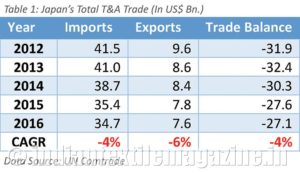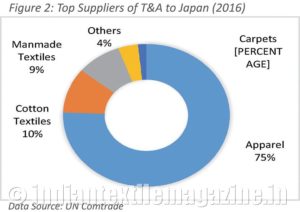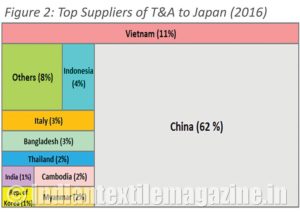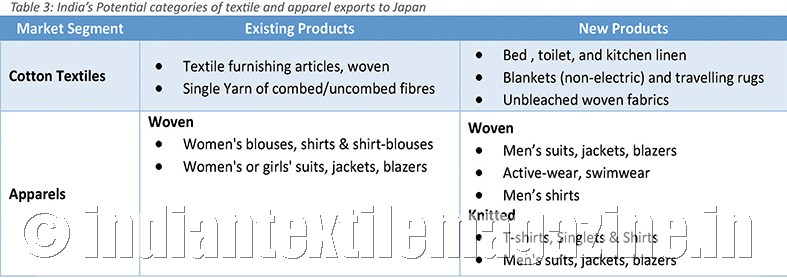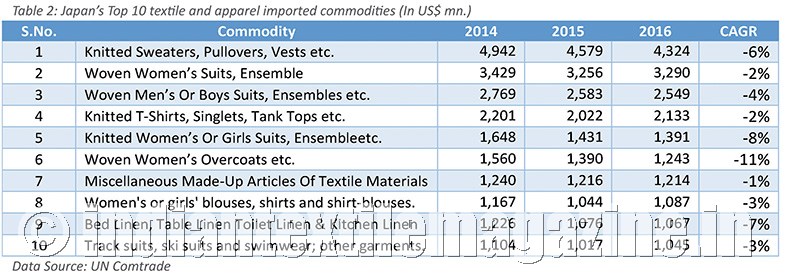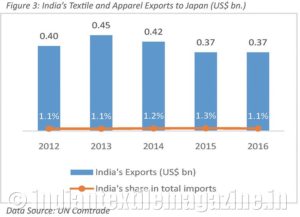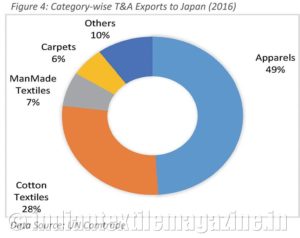Japan is the fourth largest market for textile and apparel products with imports worth $35 billion. Over the last five years, Japan’s total textile and apparel imports declined at a CAGR of -4% to reach $34.7 billion in 2016, while exports have reduced at a CAGR of -6% to reach $7.6 billion. Japan’s total textile and apparel trade balance recorded a deficit of $ 27.1 billion in 2016.
Textile and Apparel Imports Profile
Apparel is the largest imported category by Japan, representing 76% of total textile and apparel imports (2016). This is followed by cotton textiles, man-made textile with a share of 10%, and 9% respectively. Top 10 suppliers accounted for 92% of textile and apparel imports by Japan. China is the largest supplier accounting for 62% share followed by Vietnam and Indonesia with a share of 11% and 4% respectively.
India’s Textile and Apparel Exports to Japan
India is the tenth largest supplier of textile and apparel products to Japan. India’s exports of T&A to Japan stood at $373 million in 2016. It has registered de-growth at a CAGR of -2% over last five years. India’s share has remained almost constant at 1% from 2012 to 2016. Despite having market access arrangement with Japan, India has not been able to leverage its benefits.
Apparel is the largest category with a share of 49% in India’s T&A exports to Japan. This is followed by cotton textiles, man-made textiles and carpets having share of 28%, 7%, 6% respectively.
The Japanese textile manufacturing industry started shifting to other countries in 1980s due to the increase in wage cost in Japan. This led to the investment from Japan to the countries like China, Vietnam, Cambodia, Indonesia, etc. The reason for investment in these countries was low cost of production, expected market access arrangements and low shipment time. In addition, the cultural fit of these countries with Japan in terms of developing relationship and comfortable working environment for Japanese was an added advantage.
India has signed CEPA with Japan in 2010, still India’s share in Japanese market is miniscule even after seven years of implementation of the agreement. It is important to note that, China is the biggest T&A supplier to Japan nevertheless it does not enjoy any preferential trade access. This is due to the fact that Japanese market is stringent in terms of product quality, compliances and delivery timelines. India is a supplier of the similar products to the world which are imported by Japan, but due to the demand of high-end products and timely delivery by Japan, India is not competitive in Japanese market. Competitors like Vietnam and Bangladesh known for their low-cost manufacturing, have captured more market share.
India still has a high potential to increase its market share in Japan. For that, Indian exporters need to focus on high quality Indian garments and work on faster delivery schedules. Further, Japan’s sourcing model is based on using buying agents and trading firms and not direct orders. Indian exporters need to familiarize themselves with different model as well.
By Wazir Advisors
